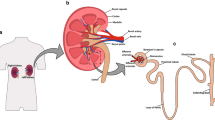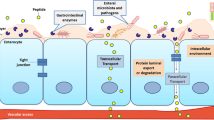Abstract
Purpose. The objective of this study was to evaluate key motif requirements of human calcitonin (hCT)-derived peptides for the permeation through the plasma membrane of MDCK monolayers, as epithelial model.
Methods. Truncated and sequence-modified fluorescent-labeled hCT-derived peptides were synthesized through Fmoc chemistry. Peptide uptake by confluent MDCK was observed by confocal laser scanning microscopy. The cytotoxic effect of the peptides on cellular integrity was followed by LDH release. For direct comparison we covered the cellular uptake of established cell penetrating peptides, Tat(47-57) and penetratin(43-58).
Results. Truncated sequences of hCT, from hCT(9-32) to hCT(18-32), penetrated the plasma membrane and demonstrated a sectoral, punctuated cytoplasmic distribution. The uptake process appeared to be temperature-, time- and concentration-dependent. Amino acid modifications of hCT(18-32) indicated that both the proline in position 23 and the positive charge of lysine in position 18 are crucial for peptide uptake. The reverse sequence hCT(32-18) did not penetrate the membrane, indicating the importance of sequence orientation. Tat(47-57) and penetratin(43-58) showed a similar punctuated cytoplasmic distribution in MDCK and HeLa cell lines. No relevant toxicity was observed.
Conclusions. Selected hCT-derived peptides have cell penetrating properties. The uptake mechanism seems to involve an endocytic pathway.
Similar content being viewed by others
REFERENCES
A. M. Gewirtz, D. L. Sokol, and M. Z. Ratajczak. Nucleic acid therapeutics: state of the art and future prospects. Blood 92:712-736 (1998).
R. L. Juliano, S. Alahari, H. Yoo, R. Kole, and M. Cho. Antisense pharmacodynamics: critical issues in the transport and delivery of antisense oligonucleotides. Pharm. Res. 16:494-502 (1999).
E. Vives, P. Brodin, and B. Lebleu. A truncated HIV-1 Tat protein basic domain rapidly translocates through the plasma membrane and accumulates in the cell nucleus. J. Biol. Chem. 272:16010-16017 (1997).
S. R. Schwarze, A. Ho, A. Vocero-Akbani, and S. F. Dowdy. In vivo protein transduction: delivery of a biologically active protein into the mouse. Science 285:1569-1572 (1999).
V. Polyakov, V. Sharma, J. L. Dahlheimer, C. M. Pica, G. D. Luker, and D. Piwnica-Worms. Novel Tat-peptide chelates for direct transduction of technetium-99m and rhenium into human cells for imaging and radiotherapy. Bioconjug. Chem. 11:762-771 (2000).
D. Derossi, S. Calvet, A. Trembleau, A. Brunissen, G. Chassaing, and A. Prochiantz. Cell internalization of the third helix of the antennapedia homeodomain is receptor-independent. J. Biol. Chem. 271:18188-18193 (1996).
G. Elliott and P. O'Hare. Intercellular trafficking of VP22-GFP fusion proteins. Gene Ther. 6:149-151 (1999).
N. Brewis, A. Phelan, J. Webb, J. Drew, G. Elliott, and P. O'Hare. Evaluation of VP22 spread in tissue culture. J. Virol. 74:1051-1056 (2000).
P. A. Wender, D. J. Mitchell, K. Pattabiraman, E. T. Pelkey, L. Steinman, and J. B. Rothbard. The design, synthesis, and evaluation of molecules that enable or enhance cellular uptake: peptoid molecular transporters. Proc. Natl. Acad. Sci. USA 97:13003-13008 (2000).
S. Futaki, T. Suzuki, W. Ohashi, T. Yagami, S. Tanaka, K. Ueda, and Y. Sugiura. Arginine-rich peptides. An abundant source of membrane-permeable peptides having potential as carriers for intracellular protein delivery. J. Biol. Chem. 276:5836-5840 (2001).
M. Pooga, U. Soomets, M. Hallbrink, A. Valkna, K. Saar, K. Rezaei, U. Kahl, J. X. Hao, X. J. Xu, Z. Wiesenfeld-Hallin, T. Hokfelt, T. Bartfai, and U. Langel. Cell penetrating PNA constructs regulate galanin receptor levels and modify pain transmission in vivo. Nat. Biotechnol. 16:857-861 (1998).
A. Astriab-Fisher, D. Sergueev, M. Fisher, B. R. Shaw, and R. L. Juliano. Conjugates of antisense oligonucleotides with the Tat and antennapedia cell-penetrating peptides: effects on cellular uptake, binding to target sequences, and biologic actions. Pharm. Res. 19:744-754 (2002).
H. Nagahara, A. M. Vocero-Akbani, E. L. Snyder, A. Ho, D. G. Latham, N. A. Lissy, M. Becker-Hapak, S. A. Ezhevsky, and S. F. Dowdy. Transduction of full-length TAT fusion proteins into mammalian cells: TAT-p27Kip1 induces cell migration. Nat. Med. 4:1449-1452 (1998).
M. Lewin, N. Carlesso, C. H. Tung, X. W. Tang, D. Cory, D. T. Scadden, and R. Weissleder. Tat peptide-derivatized magnetic nanoparticles allow in vivo tracking and recovery of progenitor cells. Nat. Biotechnol. 18:410-414 (2000).
V. P. Torchilin, R. Rammohan, V. Weissig, and T. S. Levchenko. TAT peptide on the surface of liposomes affords their efficient intracellular delivery even at low temperature and in the presence of metabolic inhibitors. Proc. Natl. Acad. Sci. USA 98:8786-8791 (2001).
T. Suzuki, S. Futaki, M. Niwa, S. Tanaka, K. Ueda, and Y. Sugiura. Possible existence of common internalization mechanisms among arginine-rich peptides. J. Biol. Chem. 277:2437-2443 (2002).
U. Koppelhus, S. K. Awasthi, V. Zachar, H. U. Holst, P. Ebbesen, and P. E. Nielsen. Cell-dependent differential cellular uptake of PNA, peptides, and PNA-peptide conjugates. Antisense Nucleic Acid Drug Dev. 12:51-63 (2002).
J. P. Richard, K. Melikov, E. Vives, C. Ramos, B. Verbeure, M. J. Gait, L. V. Chernomordik, and B. Lebleu. Cell-penetrating peptides: A re-evaluation of the mechanism of cellular uptake. J. Biol. Chem. 30:585-590 (2003).
C. R. Gaush, W. L. Hard, and T. F. Smith. Characterization of an established line of canine kidney cells (MDCK). Proc. Soc. Exp. Biol. Med. 122:931-935 (1966).
B. Rothen-Rutishauser, S. D. Kramer, A. Braun, M. Gunthert, and H. Wunderli-Allenspach. MDCK cell cultures as an epithelial in vitro model: cytoskeleton and tight junctions as indicators for the definition of age-related stages by confocal microscopy. Pharm. Res. 15:964-971 (1998).
M. Lindgren, M. Hallbrink, A. Prochiantz, and U. Langel. Cell-penetrating peptides. Trends Pharmacol. Sci. 21:99-103 (2000).
M. C. Schmidt, B. Rothen-Rutishauser, B. Rist, A. Beck-Sickinger, H. Wunderli-Allenspach, W. Rubas, W. Sadee, and H. P. Merkle. Translocation of human calcitonin in respiratory nasal epithelium is associated with self-assembly in lipid membrane. Biochemistry 37:16582-16590 (1998).
Z. Machova, C. Muhle, U. Krauss, R. Trehin, A. Koch, H. P. Merkle, and A. G. Beck-Sickinger. Cellular internalization of enhanced green fluorescent protein ligated to a human calcitonin-based carrier peptide. Chembiochem. 3:672-677 (2002).
B. Rist, M. Entzeroth, and A. G. Beck-Sickinger. From micromolar to nanomolar affinity: A systematic approach to identify the binding site of CGRP at the human calcitonin gene-related peptide 1 receptor. J. Med. Chem. 41:117-123 (1998).
P. J. A. Weber, J. E. Bader, G. Folkers, and A. G. Beck-Sickinger. A fast and inexpensive method for N-terminal fluorescein-labeling of peptides. Bioorg. Med. Chem. Lett. 8:597-600 (1998).
N. Courret, C. Frehel, N. Gouhier, M. Pouchelet, E. Prina, P. Roux, and J. C. Antoine. Biogenesis of Leishmania-harbouring parasitophorous vacuoles following phagocytosis of the metacyclic promastigote or amastigote stages of the parasites. J. Cell Sci. 115:2303-2316 (2002).
J. Moran, W. Hunziker, and J. A. Fischer. Calcitonin and calcium ionophores: cyclic AMP responses in cells of a human lymphoid line. Proc. Natl. Acad. Sci. USA 75:3984-3988 (1978).
S. R. Lang, W. Staudenmann, P. James, H. J. Manz, R. Kessler, B. Galli, H. P. Moser, A. Rummelt, and H. P. Merkle. Proteolysis of human calcitonin in excised bovine nasal mucosa: Elucidation of the metabolic pathway by liquid secondary ionization mass spectrometry (LSIMS) and matrix assisted laser desorption ionization mass spectrometry (MALDI). Pharm. Res. 13:1679-1685 (1996).
S. Lang, B. Rothen-Rutishauser, J. C. Perriard, M. C. Schmidt, and H. P. Merkle. Permeation and pathways of human calcitonin (hCT) across excised bovine nasal mucosa. Peptides 19:599-607 (1997).
R. Muff, W. Born, and J. A. Fischer. Calcitonin, calcitonin gene-related peptide, adrenomedullin and amylin: homologous peptides, separate receptors and overlapping biological actions. Eur. J. Endocrinol. 133:17-20 (1995).
A. Eguchi, T. Akuta, H. Okuyama, T. Senda, H. Yokoi, H. Inokuchi, S. Fujita, T. Hayakawa, K. Takeda, M. Hasegawa, and M. Nakanishi. Protein transduction domain of HIV-1 Tat protein promotes efficient delivery of DNA into mammalian cells. J. Biol. Chem. 276:26204-26210 (2001).
M. Lindgren, X. Gallet, U. Soomets, M. Hallbrink, E. Brakenhielm, M. Pooga, R. Brasseur, and U. Langel. Translocation properties of novel cell penetrating transportan and penetratin analogues. Bioconjug. Chem. 11:619-626 (2000).
L. A. Kueltzo and C. R. Middaugh. Potential use of non-classical pathways for the transport of macromolecular drugs. Expert Opin. Invest. Drugs. 9:2039-2050 (2000).
H. H. Bauer, U. Aebi, M. Haner, R. Hermann, M. Muller, and H. P. Merkle. Architecture and polymorphism of fibrillar supramolecular assemblies produced by in vitro aggregation of human calcitonin. J. Struct. Biol. 115:1-15 (1995).
S. Violini, V. Sharma, J. L. Prior, M. Dyszlewski, and D. Piwnica-Worms. Evidence for a plasma membrane-mediated permeability barrier to tat basic domain in well-differentiated epithelial cells: lack of correlation with heparan sulfate. Biochemistry 41:12652-12661 (2002).
S. D. Krämer and H. Wunderli-Allenspach. No entry for TAT(44-57) into liposomes and intact MDCK cells: novel approach to study membrane permeation of cell-penetrating peptides. Biochim. Biophys. Acta 1609:161-169 (2003).
H. Xia, Q. Mao, and B. L. Davidson. The HIV Tat protein transduction domain improves the biodistribution of beta-glucuronidase expressed from recombinant viral vectors. Nat. Biotechnol. 19:640-644 (2001).
M. Lundberg and M. Johansson. Positively charged DNA-binding proteins cause apparent cell membrane translocation. Biochem. Biophys. Res. Commun. 291:367-371 (2002).
C. Pichon, M. Monsigny, and A. C. Roche. Intracellular localization of oligonucleotides: influence of fixative protocols. Antisense Nucleic Acid Drug Dev. 9:89-93 (1999).
Author information
Authors and Affiliations
Corresponding author
Rights and permissions
About this article
Cite this article
Tréhin, R., Krauss, U., Muff, R. et al. Cellular Internalization of Human Calcitonin Derived Peptides in MDCK Monolayers: A Comparative Study with Tat(47-57) and Penetratin(43-58). Pharm Res 21, 33–42 (2004). https://doi.org/10.1023/B:PHAM.0000012149.83119.bf
Issue Date:
DOI: https://doi.org/10.1023/B:PHAM.0000012149.83119.bf




